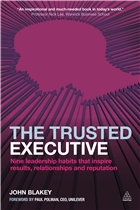Perhaps now more than ever it's time for the book by John Blakey called, The Trusted Executive: Nine Leadership Habits That Inspire Results, Relationships, and Reputation.
The book is divided into three parts:
- Part One: Blakey explores how trust in executive leadership has been lost so that we can understand the scale and depth of the problem.
- Part Two: Here, Blakey shifts from exploring the theory of trustworthiness to studying its practice. Specifically, you'll learn a three pillar approach to building trustworthiness: Habits of Ability; Habits of Integrity; Habits of Benevolence.
- Part Three: Finally, Blakey reviews the impact of the three pillars and discusses governance, remuneration, corporate social responsibility, reporting, scale, regulation and structure.
By the time you finish the book, you will also have learned about the nine habits that inspire trust. Choosing to:
- Deliver
- Coach
- Be Consistent
- Be Honest
- Be Open
- Be Humble
- Evangelize
- Be Brave
- Be Kind
Question: Of the three pillars – ability,
integrity, and benevolence – to becoming a trusted executive, which one do you
think is most important to develop?
Blakey: Some would say that the pillar of ability is most important,
since if you don’t deliver results as a business leader then you don’t get a
pass to the next stage of the game. Others might say that the pillar of
integrity is fundamental because if you are not open and honest then how can
you develop long term relationships with any of your stakeholders?
There is evidence to back up this perspective from the Institute of Leadership and Management who surveyed over 6,000 leaders in the UK and found that "openness" was, by far, the most important driver of trust ahead of "effective communication" and "ability to make decisions." However, my personal opinion is that the pillar of benevolence is the most important in today’s business world because it is the pillar most likely to be neglected by business leaders.
In my experience working as an executive coach with over 120 CEO's across 22 different countries, the benevolent skills of care, kindness and moral bravery are the most under-developed in the typical corporate leader. And this then becomes their Achilles heel. Because if you are delivering fantastic results and you are as honest as the day is long but you still drop out witty, cruel one-liners to your team members on a casual, daily basis then you will find you are still not trusted.
Question:
Let’s talk about being humble and how it relates to great leadership. It’s easy
to mistake arrogance for confidence. How do the best leaders balance their
confidence with humility and how does it lead to better teams and businesses?
Blakey:
The author, C.S. Lewis, famously said, "True humility is not thinking less of
yourself; it is thinking of yourself less."
I think this captures the difference between confidence and humility. Humble leaders can be fantastically confident and yet they still do not put themselves at the center of their own world, or anyone else’s world for that matter.
Jim Collins captured this difference when he talked about level 5 leaders in his book, Good to Great. Collins said that level 5 leaders have a paradoxical combination of "intense professional will and extreme personal humility." It is their professional will that drives them to confidently pursue ambitious organizational goals and it is their extreme personal humility which then allows them to let others take credit for these achievements.
You could argue that this behavior reveals a true, inner confidence based on a genuine self-esteem rather than the more fragile self-esteem that needs to be topped up on a daily basis by bragging and putting others down. You can imagine that working in a team with a level five leader allows everyone to give off their best, receive due recognition for their successes and be protected from random acts of blame when things go wrong. An organization full of such teams will outperform an organization populated by teams who are wasting energy covering their backs and playing political games.





Comments
Post a Comment